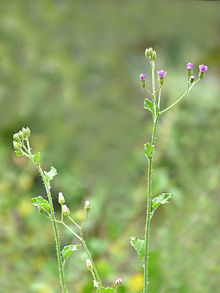짐네마 실베스트레
Gymnema sylvestre짐네마 실베스트르는[1] 아시아(아라비아 반도 포함), 아프리카, 호주 등이 원산지인 다년생 나무 덩굴이다. 그것은 아유르베딕 의학에서 사용되어 왔다. 흔한 이름으로는 짐네마,[2] 오스트레일리아 소엽식물, 숲의 페리플로카, 그리고 "설탕 구축함"[3][4][5]을 의미하는 힌디어 용어 구르마가 있다.
잎과 추출물에는 혀의 미각 수용체와 상호작용하는 주요 생체 활성 성분인 체르민산이 함유되어 있어 단맛의 맛을 일시적으로 억제한다.[6][7][8][9][10]
설명
이 식물은 윗면에 부드러운 털을 가진 나뭇잎을 가진 등산가다. 잎이 길쭉하게 돋아 있다. 그것은 작고 노란 탯줄 같은 염증을 가지고 있으며 일년 내내 생산된다.[11]
특성.
짐네마 실베스터는 한약재에 오랜 사용 역사와 광범위한 치료적 특성을 가지고 있다.[4][5][12]
단맛감각 차단
잎에는 트라이테르페노이드 사포닌,[13][14][15] 플라보놀,[16] 구르마린이 함유되어 있다.[5] 생물학적으로 가장 활발하게 활동하는 식물 분자는 트라이테르페노이드 사포닌의 일종인 체르빈산(gymnic acids)으로, 수크로스(설탕), 스테비아(stevia), 자일리톨(zylitol), 파르테임(partame) 등 인공 감미료에서 혀의 단맛을 억제하는 효과가 있다.[17]
G. sylvestre의 달콤한 차단[6][18] 효과는 15분에서 50분까지 지속되며 심지어 몇 시간 동안 지속될 수도 있다.[19] 체르민산은 분명히 맛에 장기적인 영향을 주지 않고 쓴맛, 짠맛, 신맛 인식에는 영향을 주지 않는다.[7][20]
설탕 흡수 및 인슐린 분비에 미치는 영향
짐네마 실베스트르의 질빈산 화합물도 장벽의 수용체에 부착할 수 있어 내장의 당분자 흡수를 줄이는 데 도움이 된다.[21] 이 과정은 혈당을 낮추고 인슐린 분비를 촉진하고 분비할 수 있다.[21] 그러나, 그것의 당뇨병에 걸린 성질은 쥐에서 확인되지 않았다.[22]
사용하다
- 설탕 섭취 감소: 로젠지, 구강 세척제 또는 차 형태로 섭취한 G. 실베스트르 추출물은 단 음식의 소비와 전반적인 칼로리 섭취를 감소시킨다. 추출물(민트 로젠지로 조성)은 당도가 높은 음식에 대한 욕구와 사탕의 즐거운 맛을 줄였다.[23] 연구 결과, 짐네마 실베스트레 추출물이 설탕에 대한 갈망을 줄인다고도 한다. 이중 맹목적인 연구에서, 체르민산 로젠지를 받은 참가자들은 플라시보 그룹보다 사탕을 더 자주 (시식 전) 사양했다.[10][24][25]
- 당뇨병: 인슐린이나 당뇨병 치료제와 함께 특정 체르네마 추출물(GS4)을 구강으로 복용하면 1형이나 2형 당뇨병을 가진 사람의 혈당 감소 효과가 높아진다는 초기 연구결과가 있다.[citation needed]
- 체중 감소: 일본에서는 매년 50톤의 G. 실베스터 잎이 체중 감량을 목적으로 소비되고 있다.[26][27] 초기 연구에 따르면, 체르네마 실베스트레 추출물, 히드록시시티산, 나이아신 결합 크롬을 8주 동안 입으로 섭취하면 과체중이나 비만인 사람들의 체중을 줄일 수 있다고 한다.[28]
- 기존 용도: 동양의학과 아유르베데스의학에서는 G. 실베스트르 잎과 추출물이 눈병, 알레르기, 변비, 기침, 치아 카리에스, 비만, 위장병, 바이러스 감염증 치료에 이용되어 왔다. G. 실베스트르는 항산화제, 항균제, 그리고 진통제로도 사용되었다.[5][14][26]
어원
짐네마는 그리스어인 '짐노(γμμμς)'와 '나체'를 뜻하는 nēma(νμμα)에서 유래했으며, 상피톤 실베스트르(symperton sylvestre)는 라틴어로 '숲의'을 의미한다.[29]
The Hindi and Urdu name gurmar, Sanskrit madhunashini, Malayalam chakkarakolli, Tamil சிறுகுறுஞ்சான் ,and Telugu podapatri, literally mean "sugar destroyer". (Sanskrit) meshasringa translates as "ram's horn", a name given to the plant due to the shape of its fruits.
참조
- ^ "Integrated Taxonomic Information System". www.itis.gov. Retrieved 2018-02-01.
- ^ Duke JA, ed. (2002). Handbook of medicinal herbs (2nd ed.). CRC Press. p. 855. ISBN 978-0-8493-1284-7.
- ^ Quattrocchi U (1999-11-23). CRC World Dictionary of Plant Names: Common Names, Scientific Names, Eponyms, Synonyms, and Etymology. Taylor & Francis US. ISBN 9780849326769.
- ^ Jump up to: a b Tiwari P, Mishra BN, Sangwan NS (2014). "Phytochemical and pharmacological properties of Gymnema sylvestre: an important medicinal plant". BioMed Research International. 2014: 830285. doi:10.1155/2014/830285. PMC 3912882. PMID 24511547.
- ^ Jump up to: a b c d Ulbricht C, Abrams TR, Basch E, Davies-Heerema T, Foppa I, Hammerness P, Rusie E, Tanguay-Colucci S, Taylor S, Ulbricht C, Varghese M, Weissner W, Woods J (2011). "An evidence-based systematic review of gymnema (Gymnema sylvestre R. Br.) by the Natural Standard Research Collaboration". Journal of Dietary Supplements. 8 (3): 311–30. doi:10.3109/19390211.2011.597977. PMID 22432729. S2CID 29228955.
- ^ Jump up to: a b Kurihara Y (1969). "Antisweet activity of gymnemic acid A1 and its derivatives". Life Sciences. 8 (9): 537–43. doi:10.1016/0024-3205(69)90449-4. PMID 5791706.
- ^ Jump up to: a b Gent JF, Hettinger TP, Frank ME, Marks LE (1999). "Taste confusions following gymnemic acid rinse". Chemical Senses. 24 (4): 393–403. doi:10.1093/chemse/24.4.393. PMID 10480675.
- ^ Sanematsu K, Kusakabe Y, Shigemura N, Hirokawa T, Nakamura S, Imoto T, Ninomiya Y (September 2014). "Molecular mechanisms for sweet-suppressing effect of gymnemic acids". The Journal of Biological Chemistry. 289 (37): 25711–20. doi:10.1074/jbc.M114.560409. PMC 4162174. PMID 25056955.
- ^ Gardner Z, McGuffin M (2013-03-15). American Herbal Products Association's Botanical Safety Handbook, Second Edition. CRC Press. ISBN 9781466516946.
- ^ Jump up to: a b Brala PM, Hagen RL (January 1983). "Effects of sweetness perception and caloric value of a preload on short term intake". Physiology & Behavior. 30 (1): 1–9. doi:10.1016/0031-9384(83)90030-6. PMID 6836034. S2CID 21639511.
- ^ Drury H (1869). Hand-book of Indian Flora. Madras: Trabancore Sircar Press. p. 232. ISBN 978-1-143-66359-8.
- ^ Yeh GY, Eisenberg DM, Kaptchuk TJ, Phillips RS (April 2003). "Systematic review of herbs and dietary supplements for glycemic control in diabetes". Diabetes Care. 26 (4): 1277–94. doi:10.2337/diacare.26.4.1277. PMID 12663610.
- ^ Dateo GP, Long L (September 1973). "Gymnemic acid, the antisaccharine principle of Gymnema sylvestre. Studies on the isolation and heterogeneity of gymnemic acid A1". Journal of Agricultural and Food Chemistry. 21 (5): 899–903. doi:10.1021/jf60189a030. PMID 4733385.
- ^ Jump up to: a b Di Fabio G, Romanucci V, Di Marino C, Pisanti A, Zarrelli A (2015). "Gymnema sylvestre R. Br., an Indian medicinal herb: traditional uses, chemical composition, and biological activity". Current Pharmaceutical Biotechnology. 16 (6): 506–16. doi:10.2174/138920101606150407112903. PMID 25860062.
- ^ Sinsheimer JE, McIlhenny HM (1967). "Constituents from Gymnema sylvestre leaves. II. Nitrogenous compounds". Journal of Pharmaceutical Sciences. 56 (6): 732–6. doi:10.1002/jps.2600560615. PMID 6039815.
- ^ Liu X, Ye W, Yu B, Zhao S, Wu H, Che C (March 2004). "Two new flavonol glycosides from Gymnema sylvestre and Euphorbia ebracteolata". Carbohydrate Research. 339 (4): 891–5. doi:10.1016/j.carres.2003.12.017. PMID 14980834.
- ^ Frank RA, Mize SJ, Kennedy LM, de los Santos HC, Green SJ (1992-10-01). "The effect of Gymnema sylvestre extracts on the sweetness of eight sweeteners". Chemical Senses. 17 (5): 461–479. doi:10.1093/chemse/17.5.461.
- ^ Meiselman HL, Halperin BP (1970). "Human judgments of Gymnema sylvestre and sucrose mixtures". Physiology & Behavior. 5 (8): 945–8. doi:10.1016/0031-9384(70)90187-3. PMID 5522511.
- ^ 미국의 응용 프로그램 2004071801, Edell D, Handel R, "식생활 보조 도구로서의 짐네마 실베스트르의 허발 공식" 2004년 4월 15일에 출판되었다.
- ^ Riskey DR, Desor JA, Vellucci D (1982-01-01). "Effects of gymnemic acid concentration and time since exposure on intensity of simple tastes: A test of the biphasic model for the action of gymnemic acid". Chemical Senses. 7 (2): 143–152. doi:10.1093/chemse/7.2.143. ISSN 0379-864X.
- ^ Jump up to: a b Tiwari, P; Mishra, BN; Sangwan, NS (6 January 2002). "Phytochemical and pharmacological properties of Gymnema sylvestre: an important medicinal plant.". BioMed Research International. 2014: 830285. doi:10.1155/2014/830285. PMC 3912882. PMID 24511547.
- ^ Galletto, R; Siqueira, VLD; Ferreira, EB (August 2004). "Absence of antidiabetic and hypolipidemic effect of Gymnema sylvestre in non-diabetic and alloxan-diabetic rats". Braz. arch. biol. technol. 47 (4): 545–551. doi:10.1590/S1516-89132004000400007.
- ^ Stice, Eric. "Two clinical studies confirm that Sweet Defeat reduces desire for sugar and sugar consumption".
- ^ ClinicalTrials.gov의 "Crave Crushed 행동 연구"에 대한 임상 시험 번호 NCT0274485
- ^ Stice E, Yokum S, Gau JM (2017). "Gymnemic acids lozenge reduces short-term consumption of high-sugar food: A placebo controlled experiment". Journal of Psychopharmacology. 31 (11): 1496–1502. doi:10.1177/0269881117728541. PMID 28944714. S2CID 46836377.
- ^ Jump up to: a b Ogawa Y, Sekita K, Umemura T, Saito M, Ono A, Kawasaki Y, Uchida O, Matsushima Y, Inoue T, Kanno J (February 2004). "[Gymnema sylvestre leaf extract: a 52-week dietary toxicity study in Wistar rats]". Shokuhin Eiseigaku Zasshi. Journal of the Food Hygienic Society of Japan. 45 (1): 8–18. doi:10.3358/shokueishi.45.8. PMID 15168555.
- ^ Ueno M (1993). "The bioactivity and use of the sugar absorption inhibitor "Gymnema sylvestre"". Technical Journal on Food Chemistry & Chemicals. 12: 21–26.
- ^ Preuss, H.G. (2004). "Effects of a natural extract of (-)-hydroxycitric acid (HCA-SX) and a combination of HCA-SX plus niacin-bound chromium and Gymnema sylvestre extract on weight loss". Diabetes Obes Metab. 6 (3): 171–80. doi:10.1111/j.1462-8902.2004.00328.x. PMID 15056124. S2CID 36237508.
- ^ Wikisource:신국제백과사전
추가 읽기
- Ambasta SP (1986). The useful plants of India. New Delhi: Publications & Information Directorate, Council of Scientific & Industrial Research. ISBN 978-81-85038-02-5.




